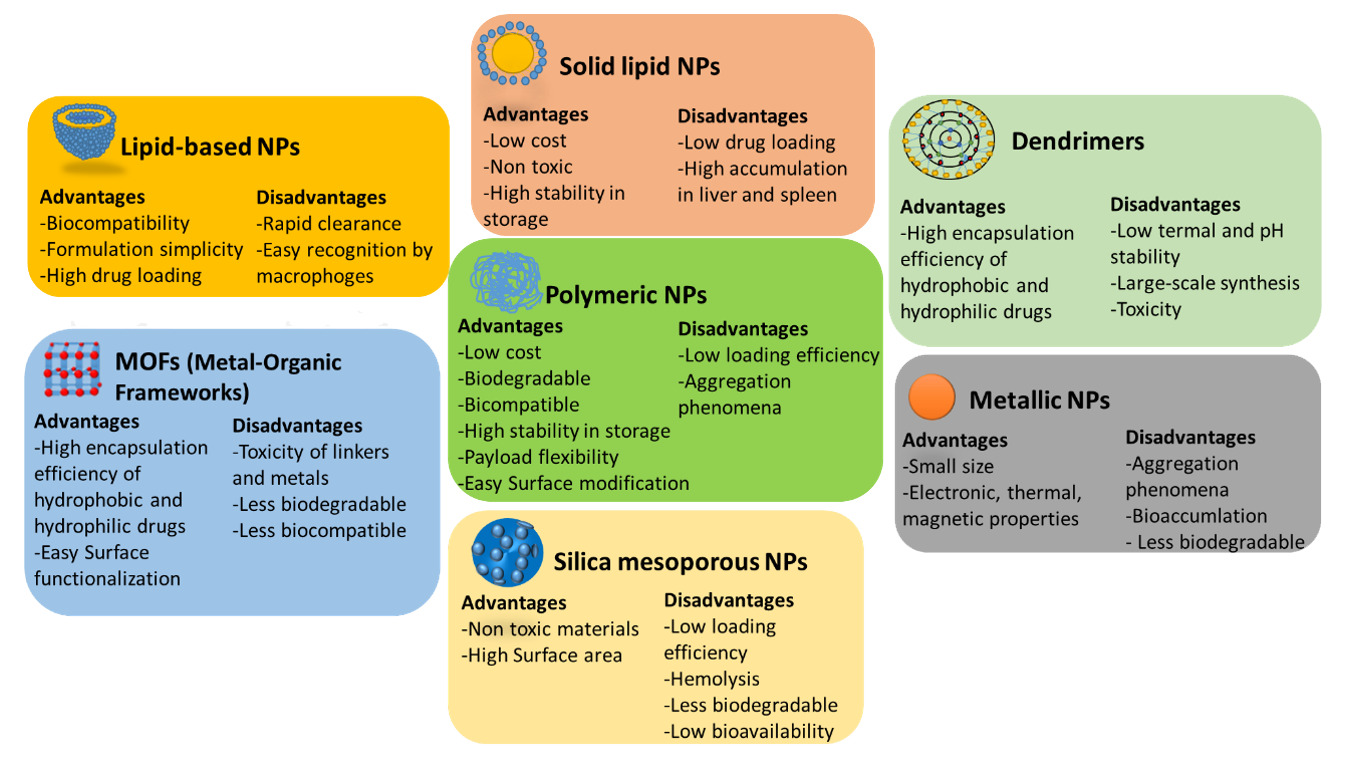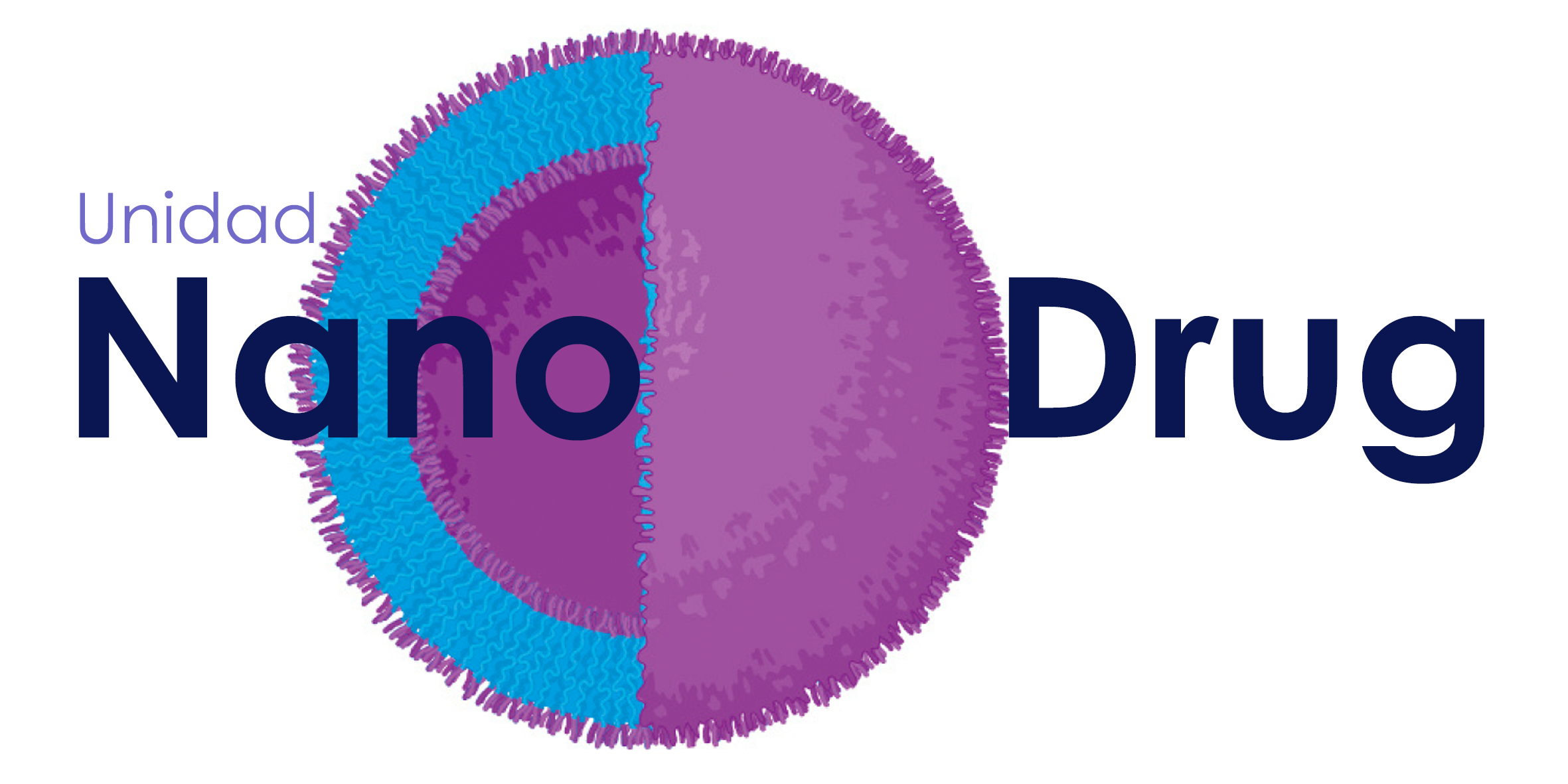Nanomedicines
Research leaders: Carlos Alonso-Moreno/Iván Bravo
Nanomedicine has raised many expectations to improve the treatment of cancer. It involves the use of nano-dimensional materials for diagnosis, and drug delivery. In the field of drug delivery, the drug is encapsulated into nanoparticles (NPs). The mechanism of action of such NPs is based on the enhanced permeability and retention effect (EPR) to favour its delivery to the site of interest by convection and diffusion processes. The EPR effect is a heterogeneous phenomenon which is inter and intra tumoural dependent. Nevertheless, those NPs circulating long enough in the bloodstream will be internalized into the tumour cells by endocytosis, so endosomes coupled to lysosomes will cleave the NPs to release the free therapeutic agent into the cytoplasm. In this sense, there is still room to improve the controlled intracellular delivery of these compounds. For examples, some strategies are based on active targeting which rely on the ligand-receptor binding to improve accumulation of the nanodevices to targeted sites. On the other hand, other studies have indicated that escape from the endocytic pathway could improve the delivery of therapeutic.
Currently, nanotechnology-based drug delivery systems can be formulated from soft (organic NPs) to hard materials (inorganic NPs). Nano-devices for drug delivery comprise a central material or matrix, a therapeutic payload and, in some cases, surface modifications. The development of a wide range of NPs capable of fitting the size, composition and functionality has provided an important resource for nanomedicine.

For more information, check some of our publications
Options to Improve the Action of PROTACs in Cancer: Development of Controlled Delivery Nanoparticles
Juan A, Del Mar Noblejas-López M, Arenas-Moreira M, Alonso-Moreno C, Ocaña A. Front Cell Dev Biol. 2022 Feb 3;9:805336. PMID: 35186955; PMCID: PMC8851355 doi: 10.3389/fcell.2021.805336.
Poly(Cyclohexene Phthalate) Nanoparticles for Controlled Dasatinib Delivery in Breast Cancer Therapy
Niza E, Nieto-Jiménez C, Noblejas-López MDM, Bravo I, Castro-Osma JA, Cruz-Martínez F, Buchaca MMS, Posadas I, Canales-Vázquez J, Lara-Sanchez A, Hermida-Merino D, Solano E, Ocaña A, Alonso-Moreno C. Nanomaterials (Basel). 2019 Aug 27;9(9):1208. PMID: 31461998; PMCID:...
Assessment of doxorubicin delivery devices based on tailored bare polycaprolactone against glioblastoma
Niza E, Castro-Osma JA, Posadas I, Alonso-Moreno C, Bravo I, Garzón A, Canales-Vázquez J, Ceña V, Lara-Sánchez A, Albaladejo J, Otero A. Pharm. 2019 Mar 10;558:110-119. Epub 2019 Jan 9. PMID: 30639216 doi: 10.1016/j.ijpharm.2018.12.079.
PEI-coated PLA nanoparticles to enhance the antimicrobial activity of carvacrol
Niza E, Božik M, Bravo I, Clemente-Casares P, Lara-Sanchez A, Juan A, Klouček P, Alonso-Moreno C. Food Chem. 2020 Oct 30;328:127131. Epub 2020 May 23. PMID: 32485586. doi: 10.1016/j.foodchem.2020.127131.
Antibody Conjugation of Nanoparticles as Therapeutics for Breast Cancer Treatment
Juan A, Cimas FJ, Bravo I, Pandiella A, Ocaña A, Alonso-Moreno C. Therapeutics for Breast Cancer Treatment. Int J Mol Sci. 2020 Aug 21;21(17):6018. PMID: 32825618; PMCID: PMC7504566. doi: 10.3390/ijms21176018.
An Overview of Antibody Conjugated Polymeric Nanoparticles for Breast Cancer Therapy
Juan A, Cimas FJ, Bravo I, Pandiella A, Ocaña A, Alonso-Moreno C. Pharmaceutics. 2020 Aug 25;12(9):802. PMID: 32854255; PMCID: PMC7558516. doi: 10.3390/pharmaceutics12090802.
Controlled Delivery of BET-PROTACs: In Vitro Evaluation of MZ1-Loaded Polymeric Antibody Conjugated Nanoparticles in Breast Cancer
Cimas FJ, Niza E, Juan A, Noblejas-López MDM, Bravo I, Lara-Sanchez A, Alonso-Moreno C, Ocaña A. Pharmaceutics. 2020 Oct 19;12(10):986. PMID: 33086530; PMCID: PMC7589709 doi: 10.3390/pharmaceutics12100986.
Mithramycin delivery systems to develop effective therapies in sarcomas
Estupiñán Ó, Niza E, Bravo I, Rey V, Tornín J, Gallego B, Clemente-Casares P, Moris F, Ocaña A, Blanco-Lorenzo V, Rodríguez-Santamaría M, Vallina-Álvarez A, González MV, Rodríguez A, Hermida-Merino D, Alonso-Moreno C, Rodríguez R. J Nanobiotechnology. 2021 Sep...
Vitamin E Delivery Systems Increase Resistance to Oxidative Stress in Red Deer Sperm Cells: Hydrogel and Nanoemulsion Carriers
Jurado-Campos A, Soria-Meneses PJ, Sánchez-Rubio F, Niza E, Bravo I, Alonso-Moreno C, Arenas-Moreira M, García-Álvarez O, Soler AJ, Garde JJ, Fernández-Santos MDR Antioxidants (Basel). 2021 Nov 6;10(11):1780. PMID: 34829650; PMCID: PMC8615287. doi:...
Characterization of Tuna Gelatin-Based Hydrogels as a Matrix for Drug Delivery
Hermida-Merino C, Cabaleiro D, Lugo L, Valcarcel J, Vázquez JA, Bravo I, Longo A, Salloum-Abou-Jaoude G, Solano E, Gracia-Fernández C, Piñeiro MM, Hermida-Merino D. Gels. 2022 Apr 12;8(4):237 doi: 10.3390/gels8040237.
Multifunctional PLA/Gelatin Bionanocomposites for Tailored Drug Delivery Systems
Moya-Lopez C, Juan A, Donizeti M, Valcarcel J, Vazquez JA, Solano E, Chapron D, Bourson P, Bravo I, Alonso-Moreno C, Clemente-Casares P, Gracia-Fernández C, Longo A, Salloum-Abou-Jaoude G, Ocaña A, Piñeiro MM, Hermida-Merino C, Hermida-Merino D. Pharmaceutics. 2022...
Enhanced Antitumoral Activity of Encapsulated BET Inhibitors When Combined with PARP Inhibitors for the Treatment of Triple-Negative Breast and Ovarian Cancers
Juan A, Noblejas-López MDM, Bravo I, Arenas-Moreira M, Blasco-Navarro C, Clemente-Casares P, Lara-Sánchez A, Pandiella A, Alonso-Moreno C, Ocaña A Cancers (Basel). 2022 Sep 15;14(18):4474. PMID: 36139634; PMCID: PMC9496913 doi: 10.3390/cancers14184474.
Vitamin E Lipid-Based Nanodevices as a Tool for Ovine Sperm Protection against Oxidative Stress: Impact on Sperm Motility
Jurado-Campos, A.; Soria-Meneses, P.J.; Arenas-Moreira, M.; Alonso-Moreno, C.; Bravo, I.; Rodríguez-Robledo, V.; Sánchez-Ajofrín, I.; Soler, A.J.; Garde, J.J.; Fernández-Santos, M.d.R. Antioxidants 2022, 11, 1988. https://doi.org/10.3390/antiox11101988.
Minimizing sperm oxidative stress using nanotechnology for breeding programs in rams
Jurado-Campos A, Soria-Meneses PJ, Arenas-Moreira M, Alonso-Moreno C, Rodríguez-Robledo V, Soler AJ, Garde JJ, Del Rocío Fernández-Santos M. J Anim Sci Biotechnol. 2023 Aug 10;14(1):106 doi: 10.1186/s40104-023-00907-3.
Macrophage Cell Membrane Coating on Piperine-Loaded MIL-100(Fe) Nanoparticles for Breast Cancer Treatment
Quijia, C.R.; Navegante, G.; Sábio, R.M.; Valente, V.; Ocaña, A.; Alonso-Moreno, C.; Frem, R.C.G.; Chorilli, M. J. Funct. Biomater. 2023, 14, 319. https://doi.org/10.3390/jfb14060319.
Chitosan-coated MIL-100(Fe) nanoparticles for enhanced piperine release in breast cancer treatment
Christian Rafael Quijia, Alberto Ocaña, Carlos Alonso‑Moreno, Regina Célia Galvão Frem, Marlus Chorilli. Journal of Molecular Structure, Volume 1305, 2024, https://doi.org/10.1016/j.molstruc.2024.137801
Volasertib: Stable Complexes with Albumin and Encapsulation into Alginate/Montmorillonite Bionanocomposites
Fernández-Sainz J, Herrera-Ochoa D, Pacheco-Liñán PJ, Darder M, Albaladejo J, Bravo I, et al. ChemRxiv. 2024; doi:10.26434/chemrxiv-2024-75qm5
Anti-EGFR conjugated nanoparticles to deliver Alpelisib as targeted therapy for head and neck cancer
Juan, A.; Segrelles, C.; del Campo-Balguerías, A.; Bravo, I.; Silva, I.; Peral, J.; Ocaña, A.; Clemente-Casares, P.; Alonso-Moreno, C.; Lorz, C.https://doi.org/10.1186/s12645-023-00180-z
Enhanced Antitumoral Activity of Encapsulated BET Inhibitors When Combined with PARP Inhibitors for the Treatment of Triple-Negative Breast and Ovarian Cancers
Juan A, Noblejas-López MDM, Bravo I, Arenas-Moreira M, Blasco-Navarro C, Clemente-Casares P, Lara-Sánchez A, Pandiella A, Alonso-Moreno C, Ocaña A. Cancers (Basel). 2022 Sep 15;14(18):4474. PMID: 36139634; PMCID: PMC9496913. doi: 10.3390/cancers14184474.
